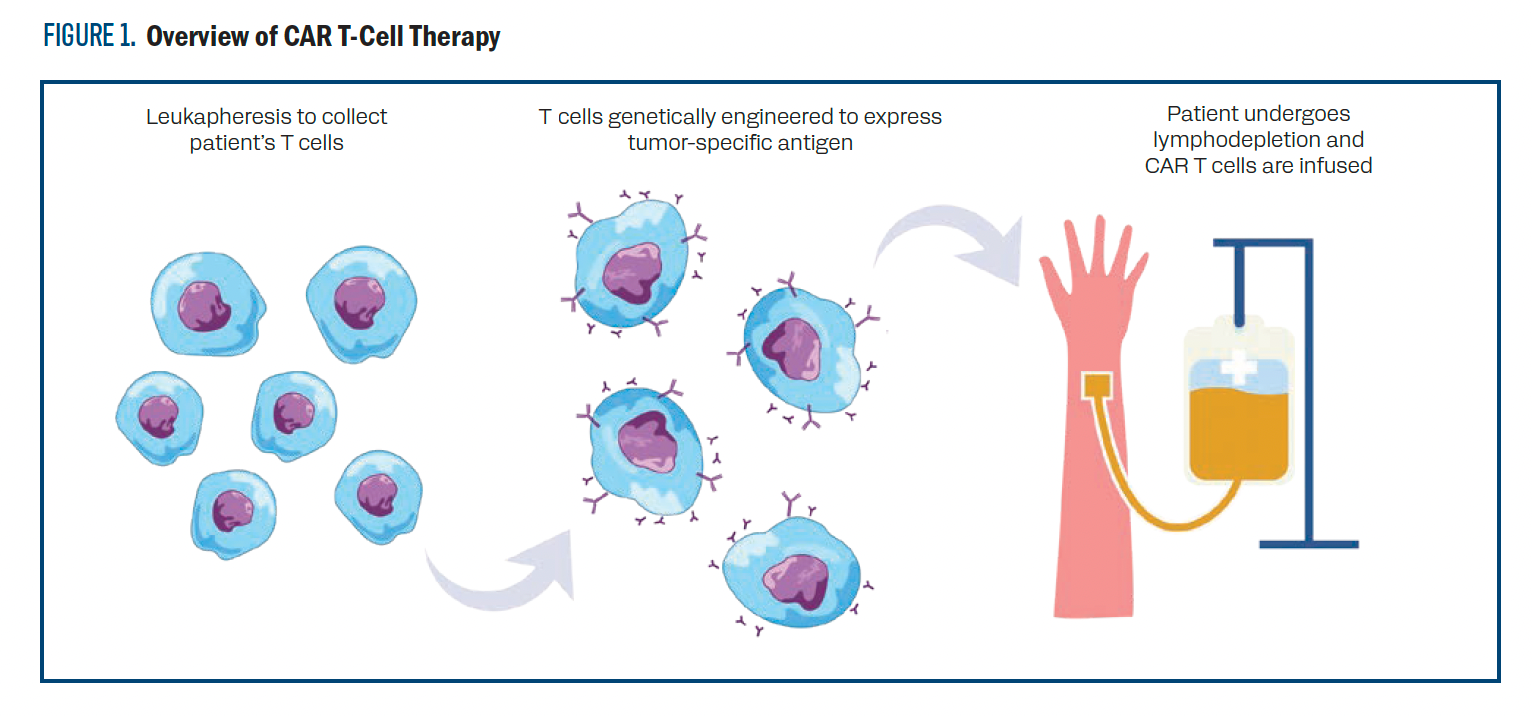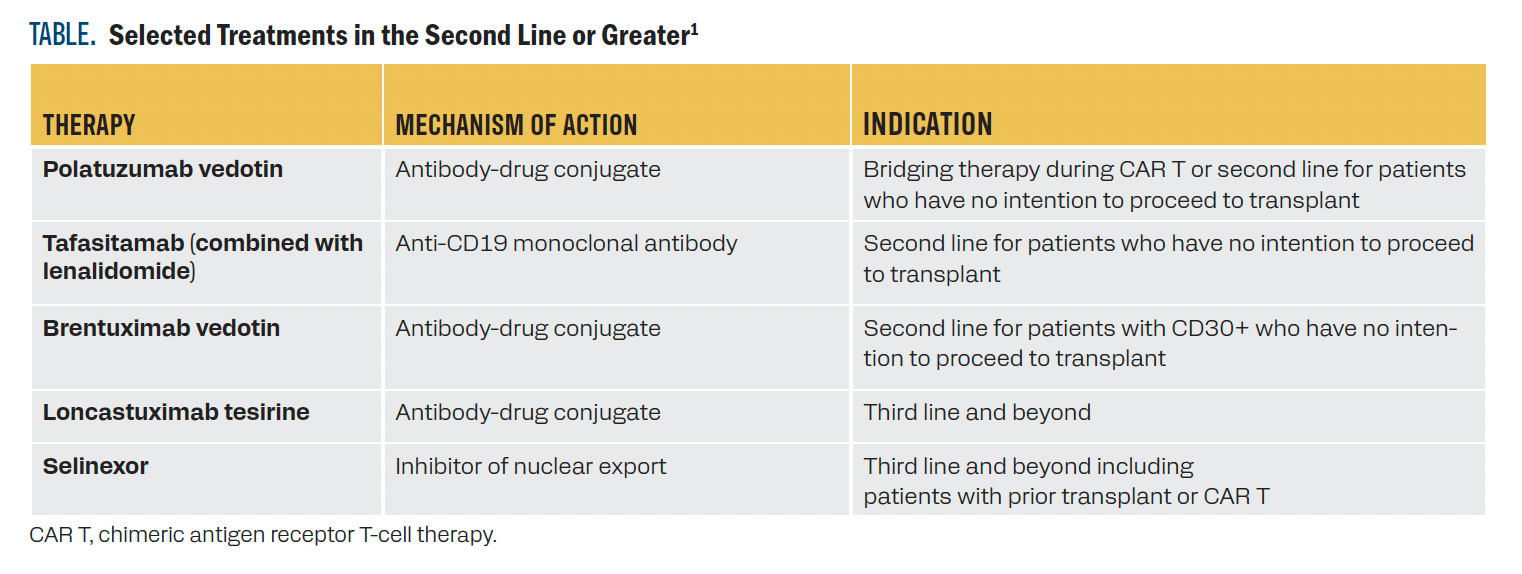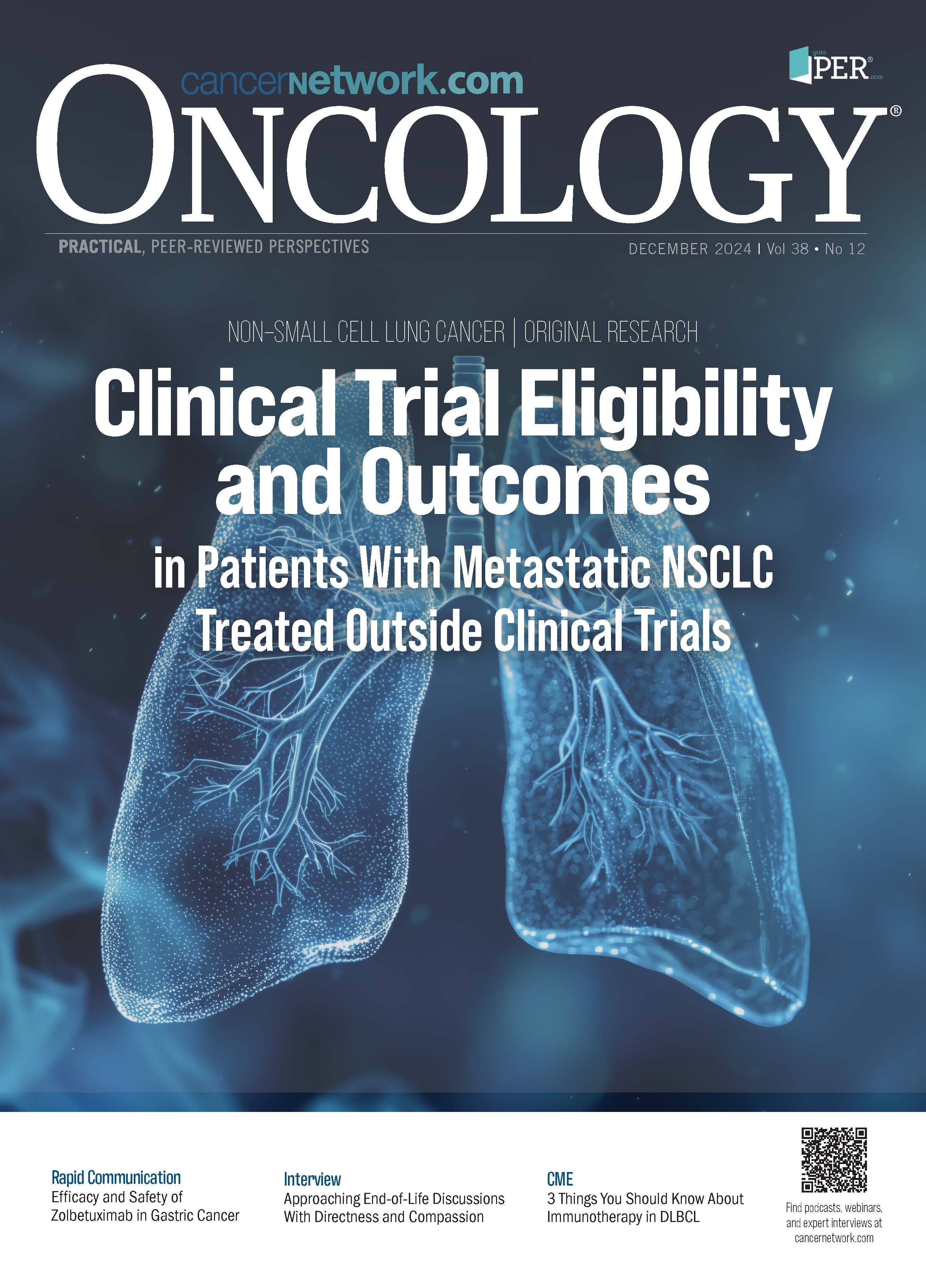3 Things You Should Know About Immunotherapy in DLBCL
Here are 3 things you should know about immunotherapy in diffuse large B-cell lymphoma.
Cytotoxic T cells play a vital role in the body’s immune defense against tumors. However, their effectiveness can be limited by factors such as the immunosuppressive nature of the tumor microenvironment and the scarcity of T cells that naturally recognize tumor-specific neoantigens. Here are 3 things you should know about immunotherapy in diffuse large B-cell lymphoma (DLBCL).
1 CAR T-cell therapy enhances the immune response to DLBCL.
Chimeric antigen receptor (CAR) T-cell therapy aims to enhance the antitumor capabilities of the adaptive immune system by collecting a patient’s T cells and modifying them genetically to express a receptor that specifically targets an antigen expressed on the patient’s tumor cells (Figure 1).
Figure 1

CD19-targeting CAR T-cell therapy consisting of either axicabtagene ciloleucel (axi-cel) or lisocabtagene maraleucel (liso-cel) is the recommended second-line therapy for patients with DLBCL who are not sensitive to chemotherapy, meaning that their disease is refractory to treatment or that it relapses within the first 12 months of first-line chemotherapy.1 Liso-cel is also a second-line therapy option for patients who do not intend to proceed to hematopoietic stem cell transplant (HSCT) based on results from the phase 2 PILOT study (NCT03483103).2 In this clinical trial, investigators administered liso-cel to 61 patients aged at least 70 years whose disease relapsed after first-line therapy who met at least 1 prespecified criterion for transplantation not intended. The overall response rate was 80% (95% CI, 68%-89%); a complete response (CR) was noted in 54% of patients. Median event-free survival (EFS) was 7.23 months (95% CI, 3.22-22.60 months). Median overall survival (OS) was not reached (NR) (95% CI, 17.28 months to NR). The most common treatment-emergent adverse events (TEAEs) of grade 3 or 4 were neutropenia (48%), leukopenia (21%), and thrombocytopenia (20%). Cytokine release syndrome (CRS) is an AE of special interest with CAR T-cell therapy; it occurred in 38% of patients in this study, including 1 grade 3 case. Neurological events, including 3 grade 3 cases, also occurred in 31% of patients.
Axi-cel was tested in the open-label, phase 2 ALYCANTE trial (NCT04531046) as second-line therapy in 62 patients aged at least 65 years with relapsed/refractory (R/R) LBCL who are ineligible for HSCT.3 The objective response rate (ORR) was 90%, including 79% of patients who had a CR. Median EFS was 12.3 months (95% CI, 7.2 months to NR). Median progression-free survival (PFS) was 11.8 months (95% CI, 8.4 months to NR). Both median OS and duration of response were not reached. Some 95.2% of patients experienced AEs of grade 3 or greater including neutropenia (66.1%), anemia (38.7%), and thrombocytopenia (38.7%). CRS was reported in 93.5% of patients, including grade 3 or 4 CRS in 8.1% of patients. Immune effector cell-associated neurotoxicity (ICANS) was reported in 51.6% of patients, including grade 3 or 4 ICANS in 14.5% of patients.
2 Bispecific antibodies provide an off-the-shelf immune enhancement option in the R/R disease setting.
For patients whose disease progressed during or after at least 2 lines of systemic treatment, which can include HSCT or CAR T-cell therapy, use of the CD3×CD20 bispecific antibodies (BsAbs) epcoritamab or glofitamab can be an option (Figure 2).1
Figure 2

In the single-arm, pivotal EPCORE NHL-1 trial (NCT03625037), 157 patients with R/R LBCL, including 139 patients with DLBCL, were given epcoritamab as a third- or later-line therapy.4 At a median follow-up of 20 months (range, 0.3-28.2 months), the ORR in patients with DLBCL was 61.9%, including CR in 39.6%. The median duration of CR was 20.8 months. CR was achieved at a median of 2.7 months from the start of treatment; however, 8 patients converted from a partial response to a CR after 36 weeks or more of follow-up. Median OS was 18.5 months (95% CI, 11.7 months to NR). TEAEs occurring in more than 20% of patients were CRS (51%), neutropenia (24%), pyrexia (24%), fatigue (23%), nausea (22%), and diarrhea (21%). In patients who experienced CRS, 94% of the events were grade 1 or 2 with the remainder being grade 3. All cases of CRS occurred after the first full dose of epcoritamab. ICANS occurred in 10 patients; 9 patients experience grade 1 or 2 events, 1 patient had a grade 5 event with confounding factors. Two fatal TEAEs (COVID-19 and ICANS) were attributed to epcoritamab therapy.
Glofitamab is another CD3×CD20 BsAb approved for use as a third-line or later treatment for patients with R/R DLBCL based on the results of a pivotal phase 2 trial (NCT03075696).5 Of 154 patients with R/R LBCL who had received at least 2 prior therapies, investigator-assessed ORR was 59%, including CR in 38%. The median duration of CR was 24.1 months (95% CI, 19.8 months to not estimated). The 18-month OS rate was 41% (95% CI, 32.1%-49.3%). CRS was reported in 64% of patients; these included grade 1 (48%), grade 2 (12%), grade 3 (3%), and grade 4 (1%) events. The most common grade 3 or 4 AE was neutropenia (27%).6 No treatment-emergent deaths were attributed to glofitamab.
3 Antibody-drug conjugates and other targeted therapies offer increased options in downstream therapy.
In addition to CAR T-cell therapy and bispecific antibodies, the DLBCL armamentarium includes a variety of treatments beyond chemotherapy for patients who have progressed on first-line therapy (Table).1 Brentuximab vedotin recently joined the list of second-line options after its use demonstrated improved ORR, CR, OS, and PFS when combined with lenalidomide and rituximab vs lenalidomide and rituximab alone in the ECHELON-3 trial (NCT04404283).7
Table

Key References
3. Houot R, Bachy E, Cartron G, et al. Axicabtagene ciloleucel as second-line therapy in large B cell lymphoma ineligible for autologous stem cell transplantation: a phase 2 trial. Nat Med. 2023;29(10):2593-2601. doi:10.1038/s41591-023-02572-5
5. Falchi L, Carlo-Stella C, Morschhauser F, et al. Glofitamab monotherapy in pts with relapsed/refractory (R/R) large B-cell lymphoma (LBCL): extended follow-up and landmark analyses from a pivotal phase II study.J Clin Oncol. 2023;41(suppl 16):7550. doi:10.1200/JCO.2023.41.16_suppl.7550
7. Kim JA, Hahn U, Kim WS, et al. Brentuximab vedotin in combination with lenalidomide and rituximab in patients with relapsed/refractory diffuse large B-cell lymphoma: results from the phase 3 ECHELON-3 study. J Clin Oncol. 2024;42(suppl 17):LBA7005. doi:10.1200/JCO.2024.42.17_suppl.LBA7005
For full reference list, visit
https://www.gotoper.com/3things24dlbcl-postref
RELEASE DATE: December 1, 2024
EXPIRATION DATE: December 1, 2025
LEARNING OBJECTIVES
Upon successful completion of this activity, you should be better prepared to:
•Assess recent pivotal trial data investigating targeted agents in patients with DLBCL across multiple lines of care.
•Select appropriate treatment strategies for patients with relapsed/refractory DLBCL considering efficacy, safety, and patient-specific factors to optimize patient outcomes.
•Discuss mechanisms of treatment resistance/lack of response in patients with DLBCL and how they can affect treatment sequencing in DLBCL.
Accreditation/Credit Designation
Physicians’ Education Resource®, LLC, is accredited by the Accreditation Council for Continuing Medical Education (ACCME) to provide continuing medical education for physicians. Physicians’ Education Resource®, LLC, designates this enduring material for a maximum of 0.25 AMA PRA Category 1 Credits™. Physicians should claim only the credit commensurate with the extent of their participation in the activity.
Acknowledgement of commercial support
This activity is supported by an educational grant from Pfizer Inc.
Off-label disclosure/disclaimer
This activity may or may not discuss investigational, unapproved, or off-label use of drugs. Learners are advised to consult prescribing information for any products discussed. The information provided in this activity is for accredited continuing education purposes only and is not meant to substitute for the independent clinical judgment of a health care professional relative to diagnostic, treatment, or management options for a specific patient’s medical condition. The opinions expressed in the content are solely those of the individual faculty members, and do not reflect those of PER or any company that provided commercial support for this activity.
Instructions for participation/how to receive credit
1. Read this activity in its entirety.
2. Go to https://www.gotoper.com/3things24dlbcl-postref to access and complete the posttest.
3. Answer the evaluation questions.
4. Request credit using the drop-down menu.
YOU MAY IMMEDIATELY DOWNLOAD YOUR CERTIFICATE.

Highlighting Insights From the Marginal Zone Lymphoma Workshop
Clinicians outline the significance of the MZL Workshop, where a gathering of international experts in the field discussed updates in the disease state.